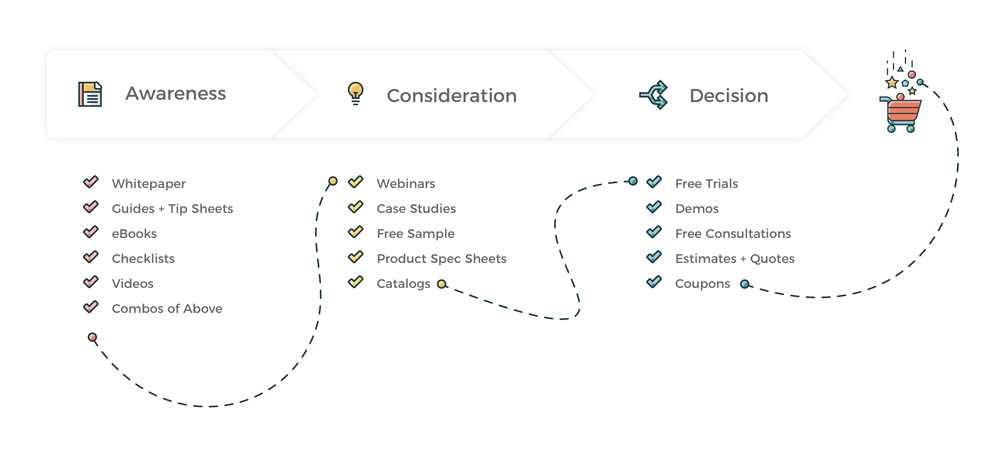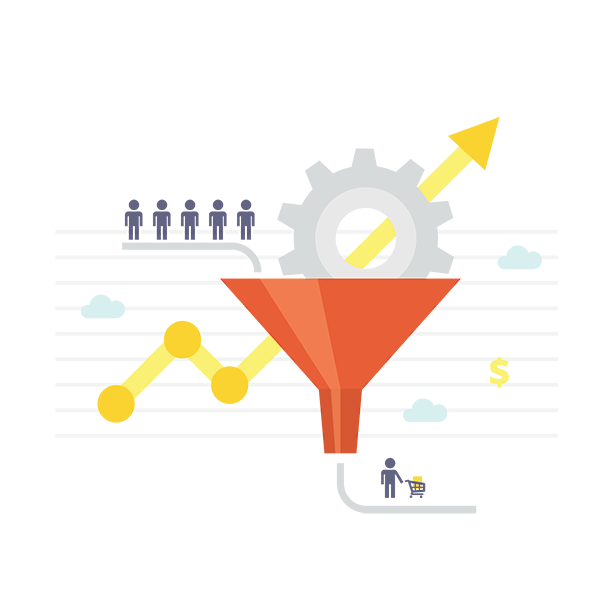Within a marketing strategy, it is important to define your contact lifecycle stages. By mapping out your customer journey and which key actions move them further into your funnel, you’ll have a better roadmap for preparing and prioritizing marketing efforts to support business goals.
What is a marketing lifecycle stage?
When thinking strategically about your target audience and the journey they might take from a stranger to a customer, the marketing lifecycle stages serve as checkpoints along that journey path. This can be useful to know if a lead has just subscribed to your blog or if they’ve requested a consultation.
The difference? Your team will want to quickly capture and follow up on the consultation user, while calling a blog subscriber too early in the funnel may scare them away. Defining customer lifecycle stages is closely tied to your users’ buyer journey.
What is the customer buyer journey?

The buyer journey is a path your customer takes from the early stages of understanding his or her problem before ultimately deciding to hire or purchase a product from your company. Within the journey are certain types of content and offers that meet the user along the way.
Defining your marketing lifecycle stages works in tandem with the buyer journey, helping you use marketing strategies and offer content that is most appropriate to users based on their lifecycle stage.
What are lifecycle stages?
There are many variations of the customer lifecycle stages, but most include these key stages to help with conversion tracking and warming up leads to pass over to sales.
Lead
The lead lifecycle stage occurs very early on in the customer journey. They may have submitted a contact form to ask a question or subscribe to your blog for regular updates and articles. You have been introduced to a lead, but they are still learning about your products and/or services and are not at a decision point yet.
Marketing-Qualified Lead
This lifecycle stage puts the contact a little further down the sales funnel. Each company defines what this looks like for them. Still, for many of our clients at TBH Creative, this might include engaging with a specific marketing campaign via an offer download, registering for a webinar, or otherwise digging a little deeper into who you are and what you do. These contacts are still not ready to commit to a sale but are warmer than the lead lifecycle stage.
Sales-Qualified Lead
In most of our work with clients, this is the sweet spot where marketing and sales collide. The sales-qualified lead lifecycle stage is a user who has expressed specific interest in proceeding with a purchase. These contacts have requested a consultation, requested a coupon code by email, have items in their cart, or otherwise are on the verge of becoming a customer but haven’t quite sealed the deal.
Opportunity
The opportunity lifecycle stage can be supported by marketing but is most often used by the sales team to distinguish contacts who are actively working through the sales process.
It’s important to note that not every sales funnel has an opportunity stage. This may apply to industries where customers are paired with an associate or team to help them get through the final hurdles of becoming customers. Examples like buying a home, deciding on a new software supplier for a company office, or other complex buyer journeys may best apply here.
Customer
Ahhh, the customer lifecycle stage. These are just whom you think they are—your customers! Depending on your industry or business model, this may be the end of the journey. For example, in an orthopedics practice, a patient who has completed a total hip replacement will hopefully no longer need hip-related care.
As most know, becoming a customer isn’t necessarily a stopping point. You may hope for recurring customers/subscriptions or a customer who originally sought out a one-time solution that now uses more of your periphery services or products. Defining this lifecycle may seem obvious, but having the ability to adjust your marketing message based on existing customers can add value.
Evangelist
Your existing customers are acting similar to brand ambassadors in the evangelist lifecycle stage and help you get the word out. This could be through an official program for representing your brand, or it could be an interior design client who is so pleased and, in turn, is telling their network about your amazing company. These folks are valuable!
How are lifecycle stages used in marketing?
We hinted at this in the lifecycle stage definitions above, but the real value of defining these stages comes in the ability to segment and target your marketing. What might this look like? Here are some examples:
- Excluding sales-qualified leads and opportunities from a blanket marketing message, such as a flash sale. Rationale: These users are lower in the funnel and closer to purchasing. You don’t want to treat them like casual strangers who have not yet engaged.
- Sending an invitation to your next webinar limited to 10 attendees about how to implement your tools and services and answer their questions to sales-qualified leads only. Rationale: If the webinar is a sales tool to help answer final questions before making the purchase, the sales team may have a quick list of invitations to send, or it may help to invite all SQLs. The messaging is not appropriate to a list of thousands of blog subscribers who are not far enough into the funnel.
- Sending a customers-only inside scoop for an upcoming event or offer to your existing customers first. Rationale: Encouraging loyalty, repeat business, and word of mouth marketing from your satisfied customers.
The segmentation and messaging possibilities are endless. Knowing where your contacts are in the buyer journey based on their actions, which designates them to lifecycle stages, is a powerful and effective tool to support marketing and sales goals.
How lifecycles stages put sales and marketing on the same team
Understanding marketing lifecycle stages can also help support the sales cycle itself with reporting and ROI data measures. If you’re not already calculating close rates from opportunities to customers, having active lists for each lifecycle stage can help to more clearly calculate this ratio.
Mapping your contacts into marketing lifecycle stages throughout their buyer journey can also help shed light on:
Length of the sales cycle: The average time to purchase or close
Best sources of new leads: Leads from certain sources close most often and/or have higher deal amounts
Lead-driven messaging: When users most want to hear from you, and what types of messaging resonates to bring them down the sales funnel
What to consider when defining your buyer journey and lifecycle stages
Armed with all of this information about the value of defining and utilizing lifecycle stages in your marketing and sales process, where should you start? Depending on the industry, capacity, and business goals, the lifecycle definition for each company can vary quite a bit.
Consider what content and conversion points you have to offer to potential leads and where each of those resources falls within the customer buyer journey. To start, your lifecycle stages may be simple. A lead has submitted a contact form on the website, a sales-qualified lead has requested to learn more or consultation, and a Customer has already made a purchase. Even defining these three stages can help you get started with understanding your buyer journey, tracking deal close metrics, and getting a better baseline for what marketing initiatives could be most useful in your specific situation.

